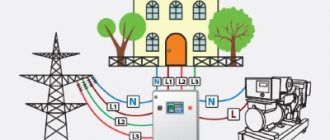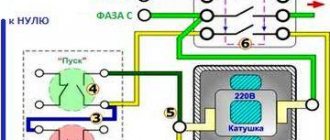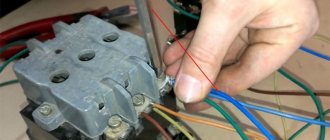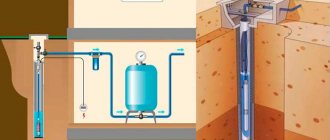A gasoline generator or its diesel analogue, at their low cost, is the most suitable source of emergency power supply for a private home or cottage. Similar installations easy to transport and use. The electrical installation of a gas generator, as well as its selection, requires a responsible approach. Incorrect connections can cause damage to household appliances or short-circuit wires in the house, not to mention it poses a danger to life. But if you know how to connect a gas generator to the home network correctly, you can restore the operation of electrical appliances quickly and safely.
How can you not do it?
When connecting a gas generator to the house, you cannot connect it to any nearby outlet without turning off the circuit breakers on the switchboard in advance.
The power of the generator can be much greater than the capacity of the outlet (usually the latter is designed for 3500 W). The result is a short circuit due to exceeding the maximum load, and a fire.
If at the same time you do not turn off the main line circuit breakers, then supplying energy to the network will lead to a breakdown of the generator.
Connecting home power through an outlet is only allowed for low-power (up to 4 kW) installations. But even in this case, it is better to connect electrical appliances to the generator via an extension cord. For powerful stations it is necessary to use an autostart system - AVR or a reversing switch.
Generator switching sequence
The main secret of safety is in following these simple rules for turning on the generator. I hung them in front of the counter so I wouldn't forget. Besides, I may not be at home, my wife will turn on)
If there is no light from the street
1. Turn off ENTER (automatic 1)
2. Go to the generator, connect it to a special outlet.
3. Check that the load switch on the generator is turned off. Also, make sure that all heavy loads in the house are turned off.
4. Start the generator, let it warm up and go into operation for at least 30 seconds.
5. Turn on the machine on the generator.
6. Turn on the required load one by one.
If the light was given
1. The appearance of voltage on the street line is indicated by a red indicator under the meter.
2. Turn off the powerful load
3. Turn off the generator, turn off the load switch at its output.
4. Pull the generator plug out of the socket.
5. Turn on the introductory machine No. 1.
All this is done automatically by the ATS system; a person only needs to pull the starter on the generator. And if the generator has automatic start, you don’t need to do anything at all!
Basic connection tasks
When installing electrical installations, the following indicators must be taken into account :
- need for automation;
- location in terms of efficiency and safety;
- stock selection;
- frequency of network outages;
- power consumption taking into account losses.
It is important to create a suitable connection diagram for a gasoline generator.
Automation of the process is expensive and requires qualified maintenance. Manual connection for a private home is the most gentle mode. Such switches are produced in two types: a changeover type switch (old model) or a reversible switch (three-way). You can find out more about them below. They also use partial automation, because semi-automatic machines are inexpensive. Regardless of the chosen method, you need to monitor the operation of the system.
Types of generators
Gasoline generator DDE GG3300P
Based on the type of fuel used in the unit, all known generating devices can be:
- gasoline;
- diesel;
- units running on gas or wood.
The first two options attract the attention of users who have taken as a basis a ready-made engine running on gasoline or diesel fuel.
Gas and wood burning devices are less efficient when used in the home and are used extremely rarely.
According to their purpose, known samples of three-phase current generators are divided into main and backup units. The question of how to connect to a household network concerns both models.
Where should the station be located?
The room should be dry , with good ventilation. In addition, a very unpleasant hum emanates from the generator during operation. Taking these nuances into account, it is better to install and connect the electrical installation in a garage, outbuilding or under a canopy.
The electric generator is installed on a foundation that does not have a rigid connection with the building. You can place the device on special shock absorbers or on a rubber cushion. This helps reduce the sound of the generator.
Installing special noise-protective enclosures also helps reduce the hum.
Input rework
The voltage from the street after the meter enters the house through a two-pole circuit breaker No. 1, and then through circuit breakers No. 2 and No. 3.
And the voltage from the generator is through machine No. 2.
The most important thing is that when the generator is running, machine No. 1 must be turned off!
What happens if you turn on the generator without turning off the input circuit breaker? In the best case, the circuit breakers will work, in the worst case, the generator will burn out, and/or the electrician of the repair team will receive a voltage shock from Victor’s generator!
It turns out that the generator is now connected to a special outlet on the wall of the summer kitchen. When the generator operates, the voltage goes to the summer kitchen, and then to machine 2, and then to machine 3 and into the house.
New circuit breakers installed
In the middle there is a 220V indicator, which is connected BEFORE the input machine, immediately after the meter. Thus, even during the day, I can immediately find out that there is light on the street, turn off the generator, and connect power from the street with automatic 1.
Connecting machines
The result is this nice design:
Electrical panel with meter and machines
Instructions for connecting to the network
After choosing the appropriate connection method, you can begin electrical installation .
The easiest way is to connect the devices to the generator outlet. No additional manipulations are required in this option. But to connect a powerful gas generator to the house, this method will not work. Here you need to follow the following instructions:
- We ground the electrical installation.
- We provide separate input. We carry it out with a high-section copper cable (at least 4 mm2) and stretch it from the distribution panel to the installation site of the gas generator.
- We install a changeover switch or a three-way switch next to the panel in order to connect the gas generator.
You can connect the generator using a semi-automatic system or ATS - you can read about this below.
How to connect a generator
I didn’t want to connect the generator through the ATS circuit, because I don’t have the knowledge or funds for this, but I decided to do everything myself and connect it without automation.
The store advised me to connect the generator directly through the outlet, but I did not do so for safety reasons. And they offered and sold me this adapter:
Cable with plugs for connecting the generator to an outlet
To make using the generator safer, I made the following socket for it on the wall of the summer kitchen:
Generator socket
The SSI-114 type socket has a cover that protects live parts. But there will always be voltage on it - both when the generator is running and from the street! I secured it higher so that the children couldn’t reach it.
I made another adapter for connection so as not to confuse it with anything else, and signed the danger warnings.
Connection cable
The fork looks like this:
Generator output plug
This is the most dangerous place in the structure. But how to avoid trouble is the secret in the connection sequence, more on that later.
Connection diagrams
How to properly connect a gas generator through a switch or three-way switch?
There are three wires coming from them. The generator network is connected to one, the utility network is connected to the other, and electrical equipment is connected to the third. Power from the mains is connected to the switch at the top, and a wire from the gas generator at the bottom. Electricity consumers are connected to the middle contacts. The switch is installed after the meter, but before the input machines. You can use a semi-automatic connection scheme. After turning off the central power supply, you need to start the device. An additionally installed time relay turns on the gas generator contactor after the engine warms up.
When the main power supply appears, it will switch to it, and an additional relay will stop the generator.
Automatic connection is even easier . The AVR system autonomously starts a backup energy source when the city network is turned off. The block is connected to the distribution panel. The connection to the gas generator is made by cable.
In addition to the use of automatic transfer switches, it is possible to use the following devices: voltage stabilizer, inverter, UPS.
Electrical wiring in the house
Before connecting the generator to the house, I analyzed the state of the house network. After the meter I had two 25A machines. I decided to immediately change them, since the wiring in the house is old.
I have many articles on choosing a circuit breaker, here is the main one. Here, in relation to the apartment.
Counter and circuit breakers.
Third, IEK is not connected. The PVS cable that goes up goes to the summer kitchen. It was decided to install the generator near the summer kitchen, under a canopy, so power from the generator will come through this cable.
Possible mistakes
In addition to connecting a powerful power station to an outlet, the home owner is capable of making the following mistakes:
- Install the unit in a windproof basement, which can lead to overheating and concentration of toxic exhaust gases.
- Place the generator outdoors – the device can be damaged by snow or rain.
- Do not make grounding.
- Incorrect input cable cross-section.
- Perform switching of a switch or reversing device under load.
All these errors can cause a short circuit in the generator circuit with unpredictable consequences.
Features of choosing and connecting an electric generator
Since connecting a gas generator to a home involves working with 3 networks at once, only people with at least a minimum of electrical knowledge should undertake it. After all, it is not easy to make the following nodes work harmoniously:
- Wires coming from the electricity generator;
- A network that transmits energy centrally;
- Grid of consumers (electrical appliances at home).
But before you start connecting, make sure that you have made the right choice of gas generator.
To do this, check its ability to operate under normal load. There is no need to conduct any experiments, you just need to know how to calculate the power of a generator for your home. To do this, calculate the power of all devices that can operate simultaneously and add 10% of the amount. Now compare with the power of the unit. If it is equal to or greater than the result obtained, then the generator is suitable for you. Example: your refrigerator consumes 1 kW/h, and your washing machine consumes 0.9 kW/h. But at the same time, the TV (0.1 kW/h) and the computer (0.5 kW/h) are working. Then the total power of the devices is 2.5 kW/h. Let's add 10%, which is 0.25 kW/h. Total – 2.75 kW/h.
Attention! The example shows inaccurate values. You can find the power of the devices in the instructions supplied with them. Don't forget to take into account all devices that consume energy. This even applies to lamps (especially incandescent): 1 such light bulb consumes 100 watts on average! And 10 of these are a whole kilowatt.
Generator autostart
Connecting the power plant to the home network through an autostart system - AVR - simplifies connecting the home to a backup power source. The system is equipped with an electric starter. The automatic start device controls the main network immediately after power is applied to it. The transfer to the backup power supply of the home network with automatic transfer switch occurs 10 seconds after the loss of voltage in the city main. Then the external network is turned off and the gas generator starts. After the engine warms up for 20 seconds, the installation is connected to the home network.
When voltage appears in the citywide main line, the source is switched off, and the home network begins to operate in standard mode.
Then the electric generator motor is turned off.
How to choose the right three-phase generator
Three-phase diesel generator PACIFIC I T16K, SDMO (France) 11.6 kW
When choosing branded units, you will have to take into account the following characteristics:
- type of energy carrier;
- device output power;
- availability of additional functions.
The type of fuel is selected taking into account specific operating conditions (convenience of storing fuel in a residential building). The output power of the purchased unit is selected taking into account the expected load; this figure varies from 5 to 6 kW for each single-phase branch. When getting acquainted with additional functionality, special attention is paid to the following features:
- adjustment of 3-phase voltage parameters (its shape, in particular);
- possibility of connecting additional lines (load capacity);
- the presence of an electromagnetic relay-regulator.
It is important to make sure that the selected model has indicator devices that allow you to visually monitor the level of each voltage.
Using a changeover switch
When the input circuit breaker is turned off, the changeover switch connects power from the power plant . This happens in stages:
- Disabling circuit breakers.
- Connecting the switch wire to the generator.
- Starting and warming up the generator.
- Supplying power to the switch.
- Switching on automatic load switches.
When electricity appears in the main network, the generator is turned off, performing the above steps in reverse order.
Generator circuit
Just in case, I provide a generator circuit and a drawing.
Electrical circuit of the inverter generator Electrical device BEG-3100
Assembly drawing and catalog of spare parts for inverter generator Electric device BEG-3100
The instructions for this generator can be easily downloaded on the Internet.
In conclusion - a photo of how potatoes are sold at our market)
The generator powers the stall and scales
Everything is simpler here, no connection diagram is needed).
Thank you all for your attention, please vote for me!
If you liked the article, you can vote for it here.
Application of ABP
The autostart system is more expensive than the manual one , but it constantly monitors the network voltage. When the voltage disappears, the contactor interrupts the connection between the ATS and the central power grid. The starter turns on and the generator starts working. Most generator owners prefer using cheaper partial automation, which works as follows:
- The main power supply is connected through a contactor that opens when the input is disconnected.
- The gas generator is started manually. A time relay is installed in it to warm up the engine and automatically switch to connecting the reserve to the home network.
- When the power supply is restored, the contactor is switched off and the load is supplied again from the public network.
A fully automated power supply system regulates the operation of the gas generator using microprocessors. Video on this topic
Generator photo
Here are a few photos of the inverter generator Elektropribor BEG-3100.
Gasoline tank. Level indicator and cover
Air intake filter
Fuel tap
Recoil starter
Oil fill
Installation of the ground loop
To ground the electric generator yourself, you will need a copper wire , a metal rod 150 cm long and 1.5 cm in cross-section. The rod is driven almost its entire length into the soil. A special clamp or a regular bolt is welded to it for easier connection of the ground wire. The copper cable runs from the rod to the appropriate terminal on the backup source.
Or, an iron sheet measuring 0.5x1 m is used as a grounding conductor. The grounding conductor is buried in the ground and connected to the unit with a wire using clamps.
With a three-phase power supply in the house, experts advise making a backup of only one phase for connection to a gas generator. It will power the necessary equipment: refrigerator, lighting, computer.
Phase imbalance in a three-phase connection is a common occurrence, and it can damage the electrical wiring of the house.
If, even after reading the instruction manual, you do not know how to safely connect a gas generator to the network at home, you should seek help from specialists.
Integration using a distribution machine
A reliable and proven option for connecting a generator to the house and the main line is to use a distribution machine. When using this method, it is important to pay attention to all the requirements that will avoid breakdowns or improper functioning of the unit. To connect, install a socket, which is located between the distribution machine and the electricity meter.
All sockets will remain energized when the machine is turned on. When it is necessary to obtain electrical supply to the house from an autonomous source, the input circuit breaker is turned off. At this point, the generator is connected to one outlet. When using this method, the load limitation is taken into account. The maximum permissible value is no more than 1 ampere.
When there is no such socket in the home network, connecting through a distribution machine becomes more complicated. In this case, remove the standard input wiring from the junction box. It is replaced by connecting phase and zero from an automated generator. If the wiring is provided with a protective device, then it is imperative to observe polarity during the connection process.
When the input wiring is disconnected from the main line that comes from the home network switchboard, you don’t have to turn it off. A test lamp is connected to the place of the wires that are disconnected. When electrical energy is supplied, light will appear. It will signal that a transition has occurred from an autonomous source to an external source.
Methods for connecting a gasoline power generator to your home
There are 3 ways to connect a gas generator to the home network:
- Using a changeover switch;
- With partial automation;
- With the installation of a unit that controls the generator automatically.
The first method is simple, but requires manual switching of power modes. In the second case, the scheme for connecting the gas generator to the home network is more complicated, but it is semi-automatic. If you need to turn on the power supply from the generator manually, then when current appears in the general network, the load itself transfers to the central power network. The latter method independently transfers the load from the general network to the generator and, vice versa, depending on the presence of voltage in the center. But it's complicated.
Attention! Regardless of the connection method you choose, make sure to ground it in advance. To do this, bury a sheet of metal in the ground, connected through a wire soldered to it, which goes to ground from a gasoline generator.
If we are talking about low-power generators that can support the operation of only one consumer, then the devices are connected directly. Such units must be portable, otherwise an extension cord will be needed. The plug from the device must be plugged into the generator socket, or into an extension cord coming from it.
Method 1
Conveniently, the method does not make it possible to power the house simultaneously from the generator and the central network. The switch through which the networks are connected can have one of three positions:
- 1 – power supply from an industrial network;
- 0 – power is not supplied;
- 2 – energy supply from a gas generator.
The switch has three levels of contacts: upper, middle and lower. Connect the central network to the top ones, and home energy consumers to the middle ones. Connect the electric current generator itself to the lower contacts.
And now about what to do if the central network is disconnected:
- Place the switch in position “0”;
- Start the generator yourself;
- Give it time to warm up;
- Move the switch to position “2”.
If voltage appears in the general network, then first you need to turn off the power completely (position “2”). Then the current generator is manually turned off. And only after that you can turn on the power from the general network.
Method 2
It is based on the use of semi-ATS (automatic transfer). If you do not affect the design of the device itself, the connection process looks the same as in the previous method. But the management principle changes:
- If the city power is lost, then you will have to go to the unit that generates the current to turn it on;
- Give it time to warm up;
- Connect the gas generator using semi-AVR contactors.
If the central power supply resumes, the contactor will automatically turn off, and the entire load will fall on the general power grid. However, semi-automatic equipment can be slightly improved by installing a time relay. Then there is no need to wait for the generator to warm up. Because the relay will do everything for you: when the unit warms up, a load will be applied to it.
Method 3
And now the best way to connect an electric generator to your home network is to switch to full automation. To connect a full-fledged ATS, you need a diagram. It can be found in the instructions with the purchased device, as well as on the panel door. But it is also shown below in the figure.
Purpose of the voltage regulator relay
Regardless of experience and driving style, the car owner cannot ensure the same engine speed at different times. That is, the crankshaft of the internal combustion engine, which transmits torque to the generator, rotates at different speeds. Accordingly, the generator produces different voltages, which is extremely dangerous for the battery and other consumers of the on-board network.
Therefore, replacing the alternator regulator relay should be done when the battery is undercharged or overcharged, the light is on, the headlights are flashing and other interruptions in the power supply to the on-board network.
Interconnection of car current sources
The vehicle contains at least two sources of electricity:
- battery - required at the moment of starting the internal combustion engine and the primary excitation of the generator winding; it does not create energy, but only consumes and accumulates at the time of recharging
- generator – powers the on-board network at any speed and recharges the battery only at high speeds
Rice. 2 In the car, the generator and battery are combined into a common network
Both of these sources must be connected to the on-board network for the correct operation of the engine and other electricity consumers. If the generator breaks down, the battery will last for a maximum of 2 hours, and without the battery, the engine driving the generator rotor will not start.
There are exceptions - for example, due to the residual magnetization of the excitation winding, the standard GAZ-21 generator starts on its own, subject to constant operation of the machine. You can start a car “from a pusher” if it has a DC generator installed; with an AC device, such a trick is impossible.
Rice. 3 Starting the internal combustion engine from the pusher
Voltage regulator tasks
From a school physics course, every car enthusiast should remember the principle of operation of a generator:
- when the frame and the surrounding magnetic field move mutually, an electromotive force arises in it
- The stators serve as the electromagnet of DC generators, the EMF, accordingly, arises in the armature, the current is removed from the collector rings
- In the alternating current generator, the armature is magnetized, electricity appears in the stator windings
Rice. 4 Operating principle of a car generator
In a simplified way, we can imagine that the magnitude of the voltage output from the generator is influenced by the value of the magnetic force and the speed of rotation of the field. The main problem of DC generators - burning and sticking of brushes when removing large currents from the armature - has been solved by switching to alternating current generators. The excitation current supplied to the rotor to excite magnetic induction is an order of magnitude lower, making it much easier to remove electricity from a stationary stator.
However, instead of terminals “–” and “+” constantly located in space, car manufacturers received a constant change in plus and minus. Recharging the battery with alternating current is not possible in principle, so it is first rectified with a diode bridge.
Rice. 5 Generator rectifier
From these nuances the tasks solved by the generator relay flow smoothly:
- adjusting the current in the excitation winding
- maintaining a range of 13.5 - 14.5 V in the on-board network and at the battery terminals
- cutting off the power to the excitation winding from the battery when the engine is turned off
Rice. 6 Purpose of the voltage regulator relay
Therefore, the voltage regulator is also called a charging relay, and the panel displays a warning light for the battery charging process. The design of alternating current generators includes a reverse current cut-off function by default.
Generator conversion
Then we work with the client.
In order to connect the generator via AVR to the house, it must be rebuilt.
5 Disassemble the generator
It is important for me to get to the wires going to the engine switch and to the 220V output.
6 Looking for the necessary wires
As in Hooter, in this generator (and I think in all others) the engine will start only when the contacts of this switch are closed.
7 Rear control panel
I connect the output cable to the generator. I use PVS cable 4x1.5. The maximum power that will be transmitted through this cable is 2 kW, the current is no more than 10A. If the current is exceeded, the generator protection should operate. In addition, these wires are protected by a 16A Q2 circuit breaker.
8 Connect the control and power cable
- Brown – phase,
- Blue - zero
- Black and white – opening of the engine switch contacts.
Let me remind you that at the generator outputs there are no concepts of “Phase” and “Zero”; the outputs are assigned by the willful decision of the electrician when connecting. And then you can’t change them.
The cable ends with a 4-pin SSI connector. In the generator state, when it is physically disconnected from the house, the following plug is installed at the end of the cable:
8_2 Generator output connector
This plug contains a jumper that allows you to turn on the generator anywhere, for example, in nature. In addition, this protects against accidental contact, since without this plug, as well as without connecting to the ATS, the generator will not turn on.
True, you will have to drag this cable (3 meters) into nature, although it will be useless there.











